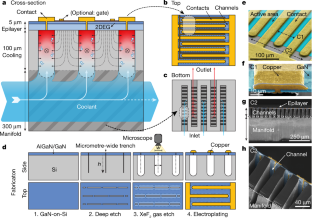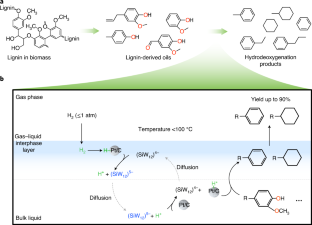(Transistor-integrated cooling for a more powerful chip)
2020/9/10 スイス連邦工科大学ローザンヌ校(EPFL)(ローザンヌ工科大学)

・ EPFL が、チップ内にトランジスタとマイクロ流体冷却システムを統合する技術を開発。
・ トランジスタサイズ縮小とチップに搭載するトランジスタ数増加の必要性が進む中、電子機器で発生する熱対策は大きな課題となっている。
・ 電気技術と冷却システムは、電気技師と機械技師によりそれぞれ個別に設計されているが、EPFLはこれらの設計ステップを一本化した。
・ エレクトロニクスとマイクロ流体冷却システムの統合技術により、大型の外部ヒートシンクを不要なものとし、トランジスタの発する大きな熱流速を効率的に制御する。
・ パワーコンバーターと複数の高電圧デバイスの単一チップ上での統合が可能となり、電子コンポーネントのエネルギー消費量低減とサイズの小型化が期待できる。
・ 同技術では、半導体チップ内に組み込んだマイクロ流体により、冷却液がチップ内を循環。シンプルで統合的な製造プロセスでマイクロ流体チャネルをトランジスタのホットスポットに近接して配置し、正確な場所で熱を取り込み、デバイス中での熱拡散を防ぐ。
・ 冷却液には導電性の無い脱イオン水を使用したが、トランジスタの発する熱をさらに多く抽出できるより効果的な他の液体の試験を実施した。レーザーや通信システム等での熱対策について調査中。
URL: https://actu.epfl.ch/news/transistor-integrated-cooling-for-a-more-powerful-/
<NEDO海外技術情報より>
(関連情報)
Nature 掲載論文(アブストラクトのみ:全文は有料)
Co-designing electronics with microfluidics for more sustainable cooling
URL: https://www.nature.com/articles/s41586-020-2666-1
Abstract
Thermal management is one of the main challenges for the future of electronics1,2,3,4,5. With the ever-increasing rate of data generation and communication, as well as the constant push to reduce the size and costs of industrial converter systems, the power density of electronics has risen6. Consequently, cooling, with its enormous energy and water consumption, has an increasingly large environmental impact7,8, and new technologies are needed to extract the heat in a more sustainable way—that is, requiring less water and energy9. Embedding liquid cooling directly inside the chip is a promising approach for more efficient thermal management5,10,11. However, even in state-of-the-art approaches, the electronics and cooling are treated separately, leaving the full energy-saving potential of embedded cooling untapped. Here we show that by co-designing microfluidics and electronics within the same semiconductor substrate we can produce a monolithically integrated manifold microchannel cooling structure with efficiency beyond what is currently available. Our results show that heat fluxes exceeding 1.7 kilowatts per square centimetre can be extracted using only 0.57 watts per square centimetre of pumping power. We observed an unprecedented coefficient of performance (exceeding 10,000) for single-phase water-cooling of heat fluxes exceeding 1 kilowatt per square centimetre, corresponding to a 50-fold increase compared to straight microchannels, as well as a very high average Nusselt number of 16. The proposed cooling technology should enable further miniaturization of electronics, potentially extending Moore’s law and greatly reducing the energy consumption in cooling of electronics. Furthermore, by removing the need for large external heat sinks, this approach should enable the realization of very compact power converters integrated on a single chip.



